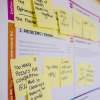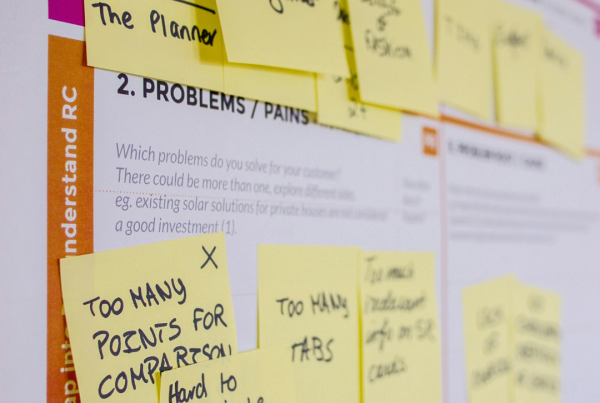In all my years of experience, I’ve never heard a leader or manager say they want their people to collaborate less. It’s always the opposite, and for good reasons. In design, great products are not usually born from one genius. They are usually a result of cumulative research, testing, and effort. Yes, maybe one person is a significant driver, but it always boils down to teamwork.
When designing products, collaboration means you are more likely to generate better ideas, and be able to catch mistakes and design flaws early on. There’s better alignment and understanding between design, engineering, marketing, and management, and things can move quickly.
However, silos do serve a purpose. We do need time to regroup, process things in hand, and work on our craft. It’s one of the reasons the open office concept has grown less popular over the years, and why we are gravitating towards hybrid arrangements for work. You shouldn’t be looking for 100% collaboration on everything, but your teams need to come together at different stages of the design and development process, and, equally important, enjoy doing so.
How to break down silos to design human-centred products
1. Establish shared goals
The first thing you need to get right off the bat is establishing a common goal across multiple teams that they can work towards together. These goals give people a sense of ownership and mandate to cooperate. They are invested early in the process and are likely to be more motivated to pitch in for the final result. An example of a common goal is a high user score review, net promoter score, product adoption rates or go-to-market metrics.
2. Reform your design process
Don’t build products like a factory line. Teams shouldn’t work in silos and then pass their output to the next team, like a baton. A collaborative design and development process means teams can put their heads together and work in parallel as needed.
You need a design process that includes key people who matter in the process. At the basic level, you need representatives from research, design, engineering or development, and sales and marketing.
One popular design process is the design thinking process. There are roughly 5-7 stages of the process, and they typically are: Empathise, Define, Ideate, Prototype, Test and Develop. Another one is the double diamond process, which is a variation of design thinking processes. They are both iterative processes, so you are continually looping back to previous stages until you get it right.
If you’re starting to break down team silos with a new process, you probably won’t get it right the first time. That’s okay because you will keep refining it based on feedback. Having an imperfect solution is better than none at all, where teams are still working in their own cocoons.
3. Assemble a cross-functional leadership team
If you have a big organisation, it’s handy to have a cross-functional leadership team, which is simply, a band of leaders from each area to establish and oversee the general direction, resolve issues, and put in measures to make sure people can do their best work.
This works well when you have multiple teams across multiple time zones working on multiple products. But even if you have a small organisation, it’s worth having a cross-functional leadership team so you can work out the nuances of your processes and workflows. They can set expectations, agree to timelines, responsibilities, and provide feedback between teams.
Furthermore, they can serve as the final decision makers when things are in a deadlock. Sometimes, it’s not about making the perfect decision that is difficult to execute, but a good decision that will balance out timeline, the business, and users.
4. Encourage knowledge sharing
You probably already have a central knowledge repository, but is it being used effectively? Are people using it, referring to it, and documenting what they know regularly?
It’s why you also need to include knowledge documenting and sharing as part of the process. I understand that a lot of time people are too busy working on the design and development to have time to put their lessons in writing. It doesn’t always have to be in a document, you can host knowledge sharing sessions, shoot a video where you walk through the thought process, or anything that makes the documenting and sharing a lot easier, so people will actually do it.
5. Communicate early, often and use a common language
Now we come to one of the most important parts of cross-collaboration, which is how people communicate. First, you need to establish a democracy type of culture, where everyone’s opinion and ideas are welcomed. It starts from the top, so, if you don’t have management doing it, it’s never going to happen.
You’ll want to set expectations, and host regular reviews and updates. Everyone should be communicating early and often to avoid disaster further down the line. When I say regular reviews and updates, I don’t mean hours-long meetings weekly, waiting for everyone to say their piece.
You need a set agenda, a timer, and everyone to come prepared. Keep it short and productive. If it can be an email or a Slack discussion, then do that instead. The most important thing is to keep the communication flowing, and not waste people’s time.
It’s also important to use a common language. A designer may not speak the same language as a marketer or an engineer. It helps to always go back to the common goal, and communicate on those terms. For example, how does this design revision achieve the common goal? Or why does this engineering approach save time? And how does this marketing messaging relay our point of difference to competitors?
6. Allow for constructive feedback between teams
This should be the golden rule: Don’t look for someone to blame, look for a solution. If someone or a team is truly at fault, everyone has to take it as a lesson and design improvements in your process. Always reserve judgements until you understand the full picture. When you’re heavily invested in looking for someone’s fault, you’re wasting precious time to rectify the problem.
Having a cross-functional leadership team makes this easier, especially if people are not used to giving feedback or receiving feedback. Leaders can gather the team’s thoughts and discuss it among themselves, and then feed it back to their respective teams.
7. Expand cross-collaboration opportunities
A quick way to break down silos is to have as many cross-collaboration opportunities as possible. You can host training, knowledge sharing sessions, and workshops between teams that will help break the ice, and let everyone understand how each team works. Don’t underestimate team building activities. They really do improve communication flows, and make people more open to collaborating.
Of course, one favourite activity of mine is running design sprints involving multiple teams. For companies without a collaborative culture, it is eye-opening to them on how easy everyone can come together and design a solution quickly.
8. Standardise cross-collaboration tools
Everyone should be using the same set of tools, and have access to the same data, especially user reviews and feedback. There will be tools that are specific to a team such as design software, coding platforms and CRMs but ideally, they should be integrated to make working seamless for people. Tools for communication, knowledge sharing, presentation, metrics, and reporting should be the same across the board.
9. Celebrate success together
Finally, you’ve worked hard together. Celebrate successes together when you achieve shared goals. For example, sales figures might seem like a sales and marketing team effort, but it’s really an overall collaboration and should be celebrated as such. Likewise, if you’re getting declining user satisfaction scores, there is a disconnect somewhere between what the user expects and what they get. This situation should be a joint effort to find out the root cause, and to fix it.







